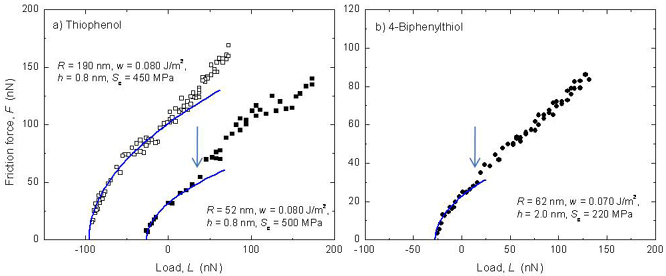

45101-G5
Friction of Self-Assembled, Polyaromatic Monolayers
This project focused on fundamental aspects of friction of polyaromatic self-assembled monolayer structures (SAMs) at solid-liquid and solid-gas interfaces. The friction of aromatic and polyaromatic systems has thus far not been extensively studied despite their occurrence and importance for the natural lubricity of mineral oils and fuels.
Materials and Methods: SAMs of thiophenol, benzyl mercaptan, 2-napthalenethiol, 4-biphenylthiol, and p-terphenylthiol on template-stripped gold were studied in single-asperity contacts with an atomic force microscope (AFM) in friction mode. The AFM tips were functionalized with the same SAMs. The strength of adhesion (interfacial energy) was altered immersing the systems in ethanol (low adhesion) or in dry N2 gas (higher adhesion). Recent contact mechanics models for thin, compliant elastic films confined between stiffer substrates were used to evaluate the data in systems with higher adhesion (in dry N2) [Johnson, K.L.; Sridhar, I: J. Phys. D: Appl. Phys. 2001, 34, 683; Sridhar et al., Ibid. 2004, 37, 2886; Reedy, E. D., J. Mater. Res. 2006, 21, 2660. Ibid. 2007, 22, 2617].
Experimental results:
In ethanol, the interfacial energy was low, gamma < 1 mJ/m2, and
a linear dependence of the friction force (F)
on load (normal force, L), with F -> 0 at L -> 0 was found in all systems (not shown). The same F was found at low L for tip radii in the range R
= 35–230 nm, i.e., F in systems with
low adhesion did not depend on the contact area, which is consistent with
previous observations [Ruths, M. J. Phys.
Chem. B 2006, 110, 2209]. The friction coefficient
decreased with increasing packing density of the SAM. F was also measured in dry N2 gas (r.h. <1.5%), where
the adhesion is higher, gamma = 35 Parameters from contact
mechanics models: The radius of the contact area was comparable in size
to the thickness of the monolayer, whose elastic modulus is 10 Discussion:
Low adhesion (in ethanol) resulted in a linear increase in friction force with
load, i.e., F = mu*L, whereas higher adhesion (in N2
gas, Figure 1) gave an apparent area-dependence of the form F = ScA. Using recently developed contact
mechanics models for confined thin films, we obtained Sc values at low load in the adhesive systems. Sc decreases with increasing
packing density, i.e., the same trend is seen as for the friction coefficient
in ethanol. The experimental data at the highest loads frequently agree less
well with the models, i.e., with the linear dependence in ethanol (not shown)
or with the solid curves in Figure 1. In some cases, a distinct onset of another
region is seen as in Figure 1a&b (arrows). Measurements with tips with
smaller radii show onsets of this divergence at lower loads [Ruths, M. ibid.]. In work on alkanethiol
monolayers [Liu, G.-y.; Salmeron, M. Langmuir
1994, 10, 367], it has been suggested that this could be caused by a
reversible displacement of molecules in the monolayer at a certain pressure.
However, in our work, the values of F
at high load are not the same as for a bare substrate, and it is therefore
unlikely that the monolayer is completely removed from the contact.
This project provided one graduate
student with the opportunity to develop expertise in surface modification and AFM
characterization techniques. The results present a deeper understanding of the
relationships between SAM structure, adhesive conditions, and friction response,
which are long-standing research interests of the PI, and the approach is
directly applicable to recently initiated projects on other types of SAMs and
on spin-coated polymer films.
